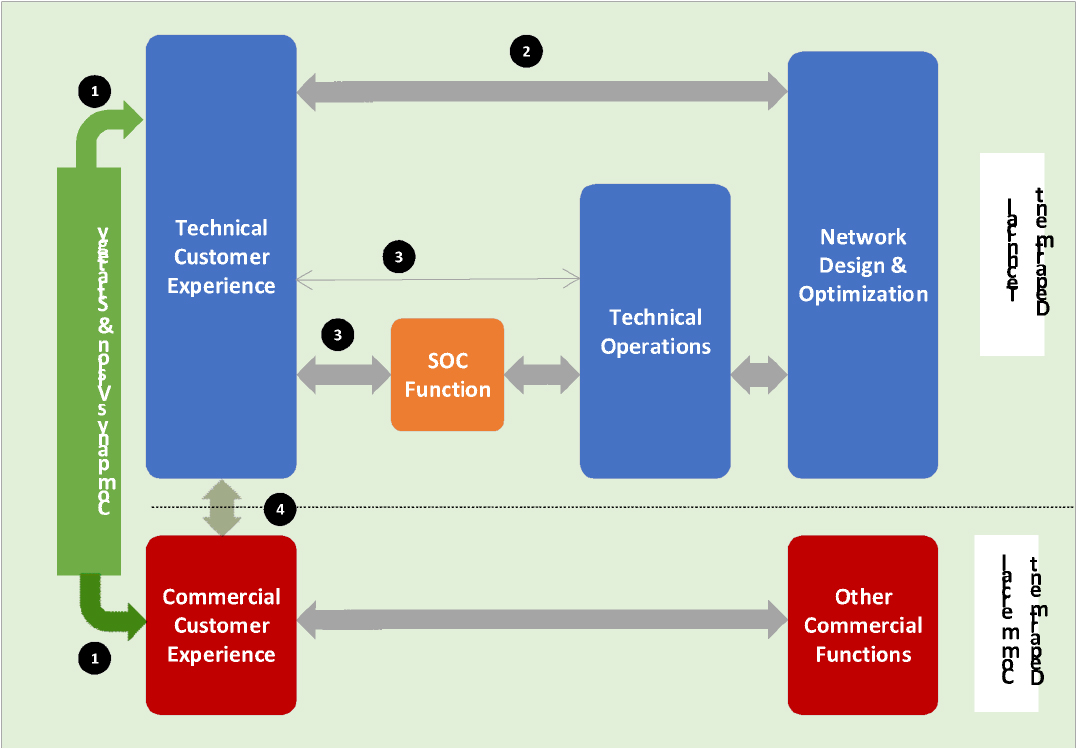CEM Framework: SOC Transformation
In this featured blog post we cover the emergence of the Customer Experience Management (CEM) framework accentuating the importance of having a dedicated customer experience team.
Embarking on the journey of SOC (Service Operations Center) transformation prompts a pivotal inquiry: does a Call Drop Rate of 0.5% represent a good or bad metric? Applying Schrodinger’s cat theory to this value unravels the multiplicity of its implications. From a network perspective, this rate may signify a positive standing. However, in the context of impacting strategic corporate accounts situated within buildings, it could potentially evoke frustration among CEOs and senior staff, thereby rendering the 0.5% rate unfavorable. This duality underscores the necessity for a broader vision that extends beyond network quality alone, focusing on service quality—a vision materialized through the SOC.
Understanding the SOC and its functionalities requires delving into the customer experience approach, especially as the telecom industry converges with rapidly advancing technology and heightened customer expectations. The advent of the Customer Experience Management (CEM) framework amplifies the significance of a dedicated customer experience team.
The primary goal of the CEM framework lies in augmenting customer satisfaction and fostering loyalty through the provision of effective technical support. This proactive approach not only contributes to sustained revenue growth but also serves as a linchpin for maintaining competitive differentiation in a dynamic market environment.
The SOC serves as the linchpin between network metrics and customer-centric service qualities. Its transformation represents a strategic shift towards a holistic perspective, acknowledging that network performance metrics, while vital, might not encapsulate the entirety of customer satisfaction. Integrating the SOC within the operational framework enables a more comprehensive
By amalgamating network-centric data with a nuanced understanding of customer needs, the SOC transformation aims to strike a delicate balance. It doesn’t dismiss the importance of network performance but rather complements it by incorporating the customer’s perception of service quality into the evaluation metrics.
In essence, the evolution of the SOC signifies a paradigm shift—a departure from a myopic focus on network metrics to a more encompassing approach that places customer experience at its core. Embracing this transformation not only elevates service delivery but also aligns telecommunications companies with the evolving landscape of customer-centricity, fostering enduring relationships and sustained growth in a fiercely competitive market.

The fundamental ethos of the SOC revolves around fostering a Customer-Centric network and operations, aligning every operational facet towards optimizing customer satisfaction.
Outlined below are the core functions that delineate the landscape of the SOC:
- Service Surveillance:
This function entails the continuous monitoring and management of service performance and quality. From fault detection to real-time response mechanisms, its aim is to minimize service disruptions while upholding stringent quality standards and Service Level Agreements (SLAs). Collaboration with network operations and customer support teams is crucial to gauge customer impact accurately. Robust reporting and documentation further drive ongoing improvements, ensuring high service reliability and customer satisfaction.
- Service Analysis:
Delving deeper into customer usage patterns, service reliability, and network efficiency, this function identifies areas for enhancement or expansion. By assessing customer satisfaction levels, it informs future service development and enhancement strategies, paving the way for proactive service improvements.
- Supporting CSI Initiatives:
The SOC actively participates in developing and executing action plans aimed at addressing identified gaps. Monitoring the impact of these changes is pivotal, as it supports continual service evolution, ensuring sustained high levels of customer satisfaction.
- Reporting:
Systematic collection, analysis, and presentation of data and insights form the backbone of this function. Accurate and regular reports are indispensable for monitoring progress, identifying improvement areas, and supporting organizational success on a holistic level.
SOC teams have the below interaction map could be described as below.

As an integral component of the SOC transformation, Mobile Network Operators (MNOs) must integrate additional tools to facilitate and fortify this evolution. Some of these crucial tools encompass:
- Network Probing tools

- OSS data Access
- Trouble ticketing Tools.
The collaborative efforts between SOC (Service Operations Center) and CEM (Customer Experience Management) teams play a pivotal role in crafting Service Key Performance Indicators (KPIs) and Key Quality Indicators (KQIs). The creation of these metrics involves a strategic alignment between operational excellence and customer-centricity, focusing on various aspects that directly impact service delivery and customer satisfaction.

SOC SKPIs centers around the following.
- Handsets Performance
- Customer Segment Performance
- HotSpots performance
- OTTs performance
- …. Etc

SOC use cases, We at Digis Squared have more than 70 ready use cases with insights and expected outputs, but use case generation is a continuous task and it shall be endless
- Customers flip-flopping between radio technologies.
- Customers with 4G handsets locked onto 3G.
- Heavy data users with 3G handsets, we offer 4G handsets.
- VoLTE performance variance across different handsets
- Geolocation for data streaming activities
- VIP and enterprise dashboards and proactive monitoring
- Happy voice and data customers
- CSFB analysis and delay investigations
- …
Let’s explore a significant use case featuring our product, INOS, specifically the SOC – Active Probing scenario. In this scenario, we implement our INOS Watcher Kits in various high-traffic locations such as hotspots, VIP customer areas, corporate settings, shops, stations, or any other locations designated by the MNO. Subsequently, we establish continuously running scripts across these watchers, enabling these kits to instantly upload testing logs.
These logs are then utilized to populate a customized SOC dashboard hosted on the cloud. This dashboard provides a comprehensive overview of all Service KPIs and KQIs categorized by device, area, location, and/or IMSI. This solution empowers us to monitor service levels in specific areas and proactively identify any potential service issues experienced by customers in those locations.

